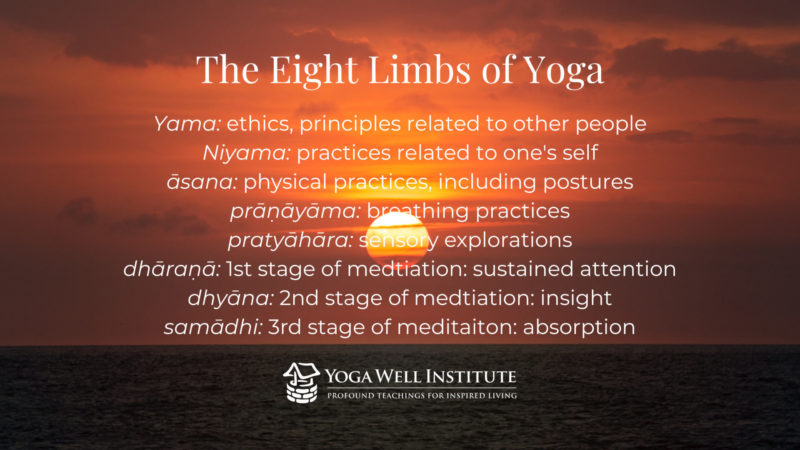YOGA’S FOUNDATIONAL TEXTS
The essential principles of Yoga as a practice, and a way of life, can be found in these three main texts: The Bhagavad Gita, The Yoga Sutras of Patanjali, and The Hatha Yoga Paradipika. The latter two especially provide practical teachings on Yoga techniques.
We frequently get the question, “Why should I study the ancient texts of Yoga? I go to class, and I have a great experience. I feel very different and I see that my life is changing. Why do I need to study the texts? What’s the point?”
We like this question.
In North America, the Yoga we generally do is the physical practice of Yoga (āsana). It is powerful, useful, and helpful in our lives, but āsana is just one part of the much larger practice of Yoga. According to the ancient texts, āsana is only one of eight significant parts of Yoga practice. There are seven other parts that are equally, if not more powerful than the physical practice. The eight limbs of Yoga presented in Patanjali’s Yogasutras are: yama (ethics), niyama (principles related to oneself), āsana (posture), prāṇāyāma (breathwork), pratyāhāra (sensory explorations), dhāraṇā (concentration), dhyāna (meditation) and samādhi (absorption).

If we can understand how āsana fits into the context of the other seven parts, Yoga can have that much more power and positive influence in our lives. Not to mention, our physical practice will be that much more rewarding. How do you know that? By studying the ancient texts.
Study Yogasūtras in Action
WHAT ARE THE ANCIENT YOGA TEXTS?
We often joke that Yoga was not invented in California twenty years ago, even though it might seem like it. But if we look at the many ancient texts composed in the last 2,000 or so years, such as Patañjali’s Yogasūtra, Haṭha Yoga Pradīpika, or the Bhagavad Gītā, we find very interesting and useful descriptions of Yoga that are not well known here in North America. When we study these texts they help us to optimize our Yoga practice because they not only explain how to practice but also how the physical practices fit into and support the greater goals of Yoga as a whole.
“The success of Yoga does not lie in the ability to perform postures but in how it positively changes the way we live our life and our relationships.” -T.K.V. Desikachar
For example, Patañjali’s Yogasūtra was composed around 350 CE (Common Era) in India in Sanskrit. It is considered one of the most important ancient texts in the study of Yoga. It gives a solid overview of the eight parts referenced above and explains how all the parts work together as a path for living. It is one of the pillars of our practice here at the Yoga Well Institute and we recommend studying it with a Yoga Mentor because it is difficult to translate into modern life when studying it alone. Receiving guidance from an experienced Yoga Mentor helps students integrate Yoga principles and practices within daily living so that they are able to experience the transformational influence of these ancient texts.
HOW TO STUDY YOGA PHILOSOPHY
There are many ways to study Yoga philosophy and experience the influence of these ancient texts in our practice and everyday life! The Yoga Well Institute has different offerings designed to support you in furthering your studies, see our recommendations below:
- Download our free ebook: Understanding Patañjali’s Yogasūtras. Our ebook is meant to provide you with an understanding of the overall presentation of the ideas in the text, their flow through the text, and how they are interlinked.
- Join us for Yogasūtras in Action a pre-recorded series that explains how Patañjali’s teachings apply to everyday living. Over 8 classes, we explore the richness of Yoga that extends beyond the poses and breathing exercises and discusses what it means to be in a state of Yoga off the mat. You won’t just study Yoga—you will discover how to live it!
- Explore the 2nd Chapter of Patañjali’s Yogasūtra: Achieving a State of Yoga a pre-recorded word-by-word deep dive into the meaning and application of Chapter 2, the sādhana pāda. Sādhana means “leading straight to a goal.” This extremely practical chapter focuses on how to attain a state of Yoga—and how to live and be Yoga.
- Get a Yoga Mentor for individualized one-to-one support in your practice and your life! Mentorship, or personal guidance, plays a vital role in understanding Patañjali’s Yogasūtra and the Viniyoga tradition. The one-to-one teacher-student relationship is how Yoga has been passed from one generation to the next down through the millennia. This unique relationship brings the context of the practice into the context of your life and can involve both practice and/or textual studies.



